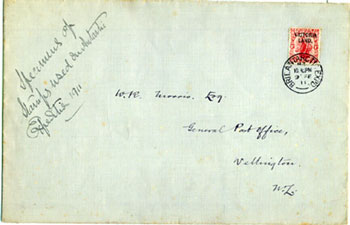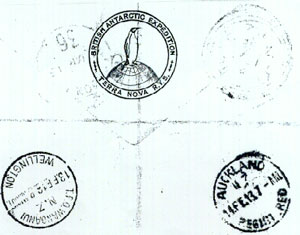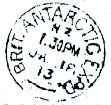Terra
Nova Expedition
1910-13
|
|
Document Enclosed: At the request of the Secretary of the Post and Telegraph Department, Wellington, New Zealand, this memento (envelope bearing a postage stamp of Victoria Land) of the establishment of a post office in Victoria Land in the Antarctic Regions is posted by Captain Robert Scott, Commander of the South Polar Exploration Expedition, and Postmaster. |
| The above mail, canceled with the 9 FE 11 datestamp, is an example of the 58 letters requested for selected addresses. The envelopes were addressed by Francis Drake, the acting Deputy Postmaster, who was Secretary of the Expedition. The envelopes were the official expedition stationery. It should be noted that Drake, as Expedition Secretary, stayed with the TERRA NOVA, and looked after the administration. It was he who undertook all the operative work of the postal arrangements and not Captain Scott, who although was appointed as Postmaster, was away at No. 8 camp at this stage. The first registered item was franked with 5 x 1d Victoria Land stamps postmarked on 9 FE 11. |
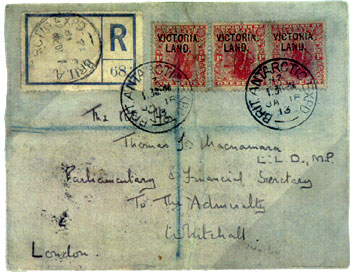 |
(Courtesy of George Hall) |
| The British Antarctic Expedition of 1910 was authorized to overprint New Zealand stamps (see below), VICTORIA LAND. Supply ships traveling from the base to New Zealand carried the mail. This letter was transferred to the Wellington Post Office where the WANGANUI carried it to England. The death of the polar party, led by Captain Scott, ended their work. Commander Evans assumed leadership in closing the camp for the return home. |
|
Mail to the expedition was sent via New Zealand where it was held for a visit from a supply ship from Antarctica. Mail received after his death was returned to the family after the base was closed in January 1913. (Courtesy of George Hall) |
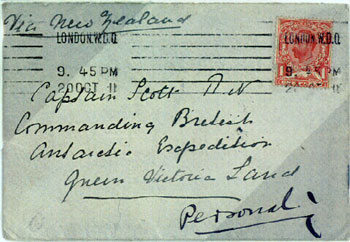 |
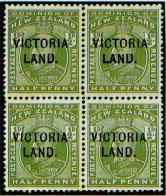 |
The second voyage of the TERRA NOVA sailed from Lyttelton, bound for Antarctica, on December 15, 1911. The ship arrived off Robertson Bay on January 3, 1912, and late on the 4th managed to get Campbell's party on board. On the 4th of February, the ship was secured alongside the fast ice off Cape Evans. The ship had intended on reaching Arrival Bay but due to poor ice conditions, these plans were abandoned and TERRA NOVA headed north for New Zealand on March 7. Professor Griffith Taylor returned with the ship and on April 1 heard that Amundsen had reached the Pole. On April 3, while berthed alongside the wharf at Lyttelton, mail was handed in to the New Zealand Post Office where it was backstamped. Lieutenant Evans and Francis Drake returned to the United Kingdom on Expedition business. The ship was refitted and laid up until the relief voyage in December. As the postage rate to some countries was 2½d, it was agreed that a small number of ½d stamps should be overprinted, to cover this rate for mail from Expedition members. On May 9, 1912, 2400 stamps were sent to the Government Printer for overprinting as with the 1d stamp. The distribution of stamps was arranged as:
The
stamps left with the TERRA NOVA, arriving at Cape
Evans on January 18, 1913. Needless to say, this issue used on
cover is rare and highly prized by polar collectors. |
|||||||||||||||
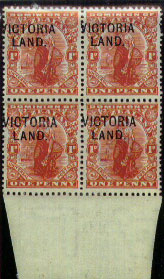 |
Sometime in the early days after the arrival of the TERRA NOVA at Lyttelton, it appears that Mr. Joseph Kinsey approached Captain Scott with ideas about the establishment of postal facilities for the expedition, and who should be responsible for these should the proposal be accepted. As a result of negotiations, 100 sheets, 240 stamps to each sheet, of the Universal Penny Postage stamp was approved for overprinting and Captain Scott was appointed Postmaster of Victoria Land. The Stamp Printing Office delivery docket showed that 200 sheets of 120 stamps were supplied for overprinting and that 3 sheets of 120 were damaged in the process. Captain Scott was officially sworn in as Postmaster of Victoria Land on November 23, 1910. The distribution of the overprinted stamps was as follows:
|
|
". . . Harmless souvenirs
so long as they remained on the printed paper on which they were
sold."
|
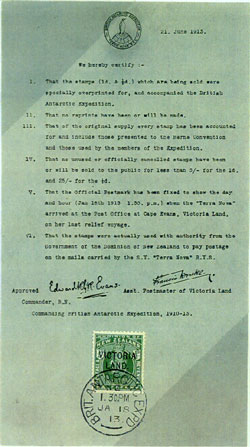 |
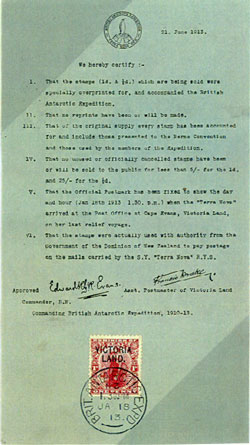 |
| In memory of the death of the Scott party, certified remainders of the overprinted stamp stocks were canceled on the day and hour the last relief ship arrived in New Zealand and sold for the benefit of a publishing fund. |
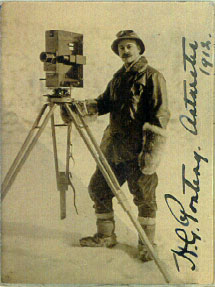
Expedition photographer Herbert Ponting
Roald
Amundsen
Fram Expedition
1910-12
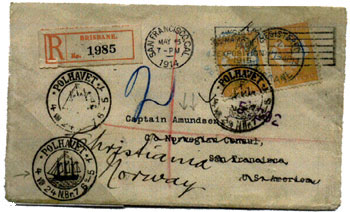 |
South Pole to the North Pole Polar Drift Voyage
Following Roald Amundsen's attainment of the South Pole in 1911, Amundsen planned an eight year polar drift. The first step was a passage through the new Panama Canal, but construction delays prevented it. Amundsen returned to Norway where he became successful in War Construction, and then returned with a new boat, the MAUD, in 1918 to set out on his original polar drift plan. |
| This
bi-polar cover was protected, somehow, after mailing it from New
Zealand. It was carried throughout the entire voyage and received
postal markings through 1924. (Courtesy of George Hall) |
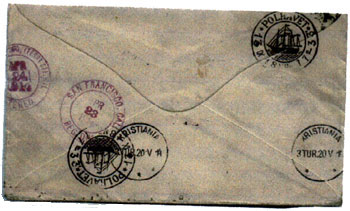 |
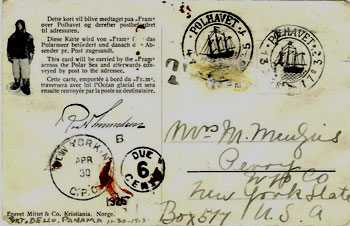 |
Although carried aboard the MAUD on its historic 1918-1922 Arctic Drift Expedition, and canceled with its on-board official date stamper, this card actually was purchased from the Amundsen South Pole Expedition, returning from its South Pole attainment while awaiting passage through the soon-to-be-opened Panama Canal. While it documents Amundsen's next expedition aboard MAUD, it also documents his South Pole attainment expedition returning aboard FRAM, as noted in the manuscript (lower left side of the card). (Courtesy of Herb & Janice Harvis) |
